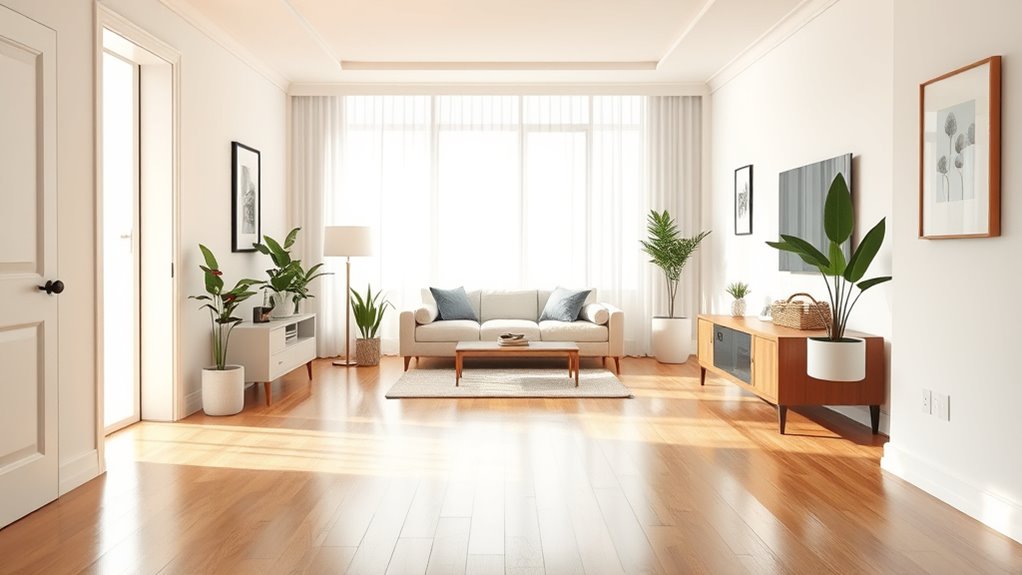To arrange open pathways in your living room, start by visualizing main routes for easy movement and keep pathways at least 24 to 36 inches wide. Place large furniture like sofas against walls to create clear corridors, and avoid blocking doorways or walkways. Use rugs, lighting, and decor to define zones without cluttering paths. If you continue exploring, you’ll discover how to balance aesthetics with functional flow for a more inviting space.
Key Takeaways
- Visualize main routes and ensure pathways are at least 24-36 inches wide for comfortable movement.
- Position large furniture like sofas against walls to keep central pathways open.
- Arrange seating to create inviting zones while maintaining clear walkways behind or around furniture.
- Place smaller furniture and decor to complement pathways without obstructing circulation.
- Use lighting, rugs, and decor to define spaces and keep pathways unobstructed for easy navigation.

Creating clear pathways in your living room is essential for both functionality and flow. When you focus on furniture placement, you’re not just arranging pieces to look good—you’re shaping how people move through the space. Good traffic flow ensures that everyone can navigate smoothly without feeling cramped or bumping into furniture. To achieve this, start by visualizing the main pathways you want to establish. Think about the natural routes people take when entering, exiting, or moving around the room. These pathways should be wide enough for comfortable passage, typically at least 24 to 36 inches, so they don’t feel restrictive or awkward.
Creating unobstructed pathways enhances flow and comfort in your living room design.
When arranging your furniture, keep in mind that large pieces like sofas and armchairs should be positioned to create open corridors. Avoid blocking doorways or walkways with oversized furniture that hampers traffic flow. Instead, consider placing sofas against walls or away from main traffic routes. This not only opens up the space but also makes it easier for people to circulate without obstruction. For example, positioning a sofa parallel to the longest wall creates an inviting seating area while maintaining clear walkways on either side. Coffee tables and side tables should be scaled appropriately and placed so they don’t impede movement—leaving enough clearance around them is key.
Don’t forget about the placement of smaller furniture pieces like ottomans, consoles, or shelves. These should complement the main pathways rather than disrupt them. For instance, placing a console table behind a sofa can add style and storage without blocking a traffic route. When designing your layout, keep in mind that furniture should facilitate, not hinder, conversation and interaction. Chairs arranged in a semi-circle or facing the main seating area should also leave enough space for people to walk behind or around them comfortably. Additionally, affordable furniture options can help you optimize space without sacrificing style.
Lighting and decor can influence the perception of space and pathways too. Keep pathways well-lit and free of clutter—both visually and physically. Rugs, while adding comfort and style, should be large enough to anchor furniture without fragmenting pathways or creating trip hazards. Overall, your goal is to strike a balance: create pathways that are unobstructed yet define functional zones within your living room. When furniture placement is thoughtful and considers traffic flow, your living room becomes a welcoming, easy-to-navigate space that invites relaxation and socializing.
Frequently Asked Questions
How Can I Maximize Space for Open Pathways in Small Living Rooms?
To maximize space for open pathways, choose artful decor that’s streamlined and functional, avoiding clutter. Use light color schemes to make the room feel larger and more open. Arrange furniture against walls to create clear routes, and keep the center of the room free of bulky items. By balancing decor with smart layout choices, you’ll open up the space, making it feel airy and inviting without sacrificing style.
What Are the Best Furniture Types to Maintain Clear Pathways?
You should choose low-profile, streamlined furniture like slim sofas and multi-functional pieces to maintain clear pathways. Opt for furniture arrangement that keeps traffic flow optimized by placing larger pieces against walls and leaving central areas open. Avoid bulky items that block movement, and consider using rugs to define zones without cluttering walkways. This approach helps maximize space and guarantees smooth traffic flow throughout your living room.
How Do I Balance Aesthetics and Functionality in Pathway Design?
Sure, balancing aesthetics and functionality might seem impossible, but it’s easier than you think. You’ll want to choose artificial lighting that highlights textured rugs and guides movement smoothly. Keep pathways clear, yet add visual interest with stylish furniture and accents. Think of it as a dance — where visual appeal and practical flow move seamlessly together. With this approach, your living room becomes both beautiful and easy to navigate, effortlessly.
Are There Specific Lighting Tips to Highlight Open Pathways?
You can highlight open pathways by combining ambient and accent lighting. Use soft ambient lights to create a gentle overall glow that guides the eye naturally along the path. Add accent lighting, like spotlights or LED strips, to emphasize key features or edges of the pathway. This layered lighting approach not only enhances visibility but also adds depth and ambiance, making your living room feel warm, inviting, and well-defined.
How Can I Prevent Furniture Placement From Obstructing Pathways?
Like a modern-day Marie Antoinette, you should prioritize smooth traffic flow by placing furniture with appropriate height to avoid blocking pathways. Keep larger pieces away from main walkways, ensuring they don’t impede movement. Measure your space and plan furniture placement thoughtfully, creating clear open pathways. This way, your living room remains functional and inviting, and traffic flow stays seamless. Remember, strategic placement is key to an unobstructed, stylish space.
Conclusion
By clearing your living room pathways, you create a tapestry of openness that invites joy and connection. Every unobstructed route becomes a gentle river flowing through your space, guiding you effortlessly from one moment to the next. When you arrange your furniture thoughtfully, you breathe life into your home, transforming it into a sanctuary where movement and comfort dance in perfect harmony. Embrace these simple changes, and watch your living room blossom into a haven of serenity and warmth.









